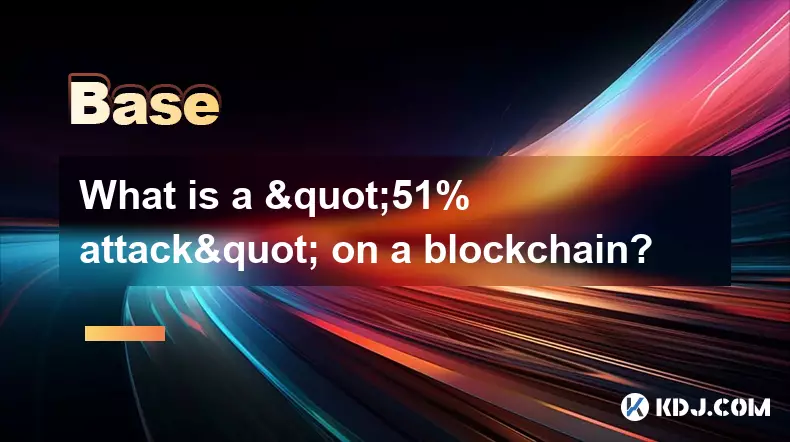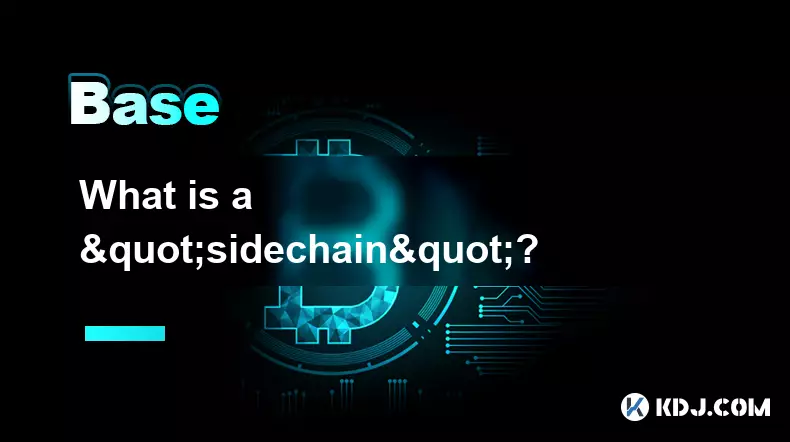-
 bitcoin
bitcoin $114684.631706 USD
-0.87% -
 ethereum
ethereum $4228.677447 USD
1.58% -
 bnb
bnb $1294.880693 USD
-1.16% -
 tether
tether $1.000819 USD
-0.02% -
 xrp
xrp $2.605138 USD
2.79% -
 solana
solana $209.908690 USD
5.89% -
 usd-coin
usd-coin $0.999903 USD
-0.03% -
 dogecoin
dogecoin $0.213423 USD
2.93% -
 tron
tron $0.322721 USD
-0.10% -
 cardano
cardano $0.727247 USD
3.66% -
 hyperliquid
hyperliquid $42.339456 USD
6.05% -
 chainlink
chainlink $19.910811 USD
5.16% -
 ethena-usde
ethena-usde $1.000557 USD
0.00% -
 stellar
stellar $0.349734 USD
2.69% -
 bitcoin-cash
bitcoin-cash $543.848687 USD
-0.21%
What is a "51% attack" on a blockchain?
A 51% attack occurs when a single entity controls over half a blockchain's hash power, enabling double-spending and transaction manipulation, undermining trust and security.
Oct 11, 2025 at 02:01 pm

Understanding the Concept of a 51% Attack
1. A 51% attack refers to a scenario in which a single entity or group gains control over more than half of a blockchain network’s computational power, also known as hash rate. This dominance allows them to manipulate the validation process of new blocks.
2. In proof-of-work blockchains like Bitcoin, miners compete to solve complex cryptographic puzzles. The first to solve it adds a new block and receives rewards. When one miner or mining pool surpasses 50% of the total network hashing capacity, they can outpace all other participants consistently.
3. With majority control, the attacker can prevent new transactions from being confirmed, reverse transactions they made while in control, and even halt other miners from completing blocks. This undermines the decentralized nature of the blockchain.
4. While such an attack does not allow the creation of new coins out of thin air or the theft of funds directly from others’ wallets, it does enable double-spending. An attacker could send cryptocurrency to an exchange, withdraw fiat or another asset, then reverse the original transaction by rewriting the blockchain ledger.
5. The feasibility of a 51% attack depends heavily on the size and distribution of the network's hashing power. Larger networks like Bitcoin are highly resistant due to the enormous cost and resources required to amass such control.
How a 51% Attack Impacts Trust and Security
1. Once a blockchain suffers a successful 51% attack, confidence in its integrity plummets. Users, traders, and exchanges may lose faith in the network’s ability to maintain accurate and tamper-proof records.
2. Exchanges often respond by delisting the affected coin or suspending deposits and withdrawals. This leads to sharp price declines and reduced liquidity, further destabilizing the ecosystem.
3. Smaller cryptocurrencies with less distributed mining pools are especially vulnerable. Several altcoins have experienced 51% attacks, resulting in millions of dollars lost through double-spent transactions.
4. Even if the network recovers technically, reputational damage lingers. Investors begin questioning whether the project has adequate safeguards or long-term viability when basic security assumptions are violated.
5. Repeated attacks signal deeper issues within the consensus mechanism or governance model. They expose weaknesses that malicious actors can exploit repeatedly unless structural changes are implemented.
Real-World Instances and Their Consequences
1. In 2018, the cryptocurrency Verge (XVG) suffered a 51% attack where attackers exploited a vulnerability in its time synchronization system, allowing them to mine over 35 million coins in a short period.
2. Ethereum Classic (ETC) faced multiple 51% attacks in 2019 and 2020. During one incident, over $1 million worth of ETC was double-spent, prompting major exchanges like Coinbase to temporarily suspend trading.
3. Bitcoin Gold (BTG), a Bitcoin fork, experienced a significant attack in 2018 and again in 2020. Attackers reversed transactions totaling around $70,000, highlighting how even moderately established projects remain at risk.
4. These events demonstrated that reliance on smaller hash rates makes certain blockchains attractive targets. Attackers can rent hash power through services like NiceHash, lowering the barrier to executing such assaults.
5. The aftermath often includes emergency protocol updates, chain rollbacks, and community debates about centralization versus security trade-offs, revealing tensions inherent in maintaining decentralized systems.
Frequently Asked Questions
Can a 51% attack happen on Bitcoin?While theoretically possible, launching a 51% attack on Bitcoin would require immense financial and computational resources. The current hash rate makes such an attempt economically unfeasible for any realistic attacker.
Does a 51% attack destroy a blockchain permanently?No, a blockchain can continue operating after an attack. However, recovery requires coordination among node operators and miners to reject the malicious chain and restore consensus on the legitimate version.
How can projects protect against 51% attacks?Some adopt alternative consensus mechanisms like proof-of-stake, increase confirmation requirements for transactions, or implement checkpointing where trusted nodes validate critical blocks.
Is double-spending the only outcome of a 51% attack?Primarily yes. The most damaging effect is the ability to reverse transactions and spend the same coins twice. Other disruptions include blocking new transactions and censoring specific addresses.
Disclaimer:info@kdj.com
The information provided is not trading advice. kdj.com does not assume any responsibility for any investments made based on the information provided in this article. Cryptocurrencies are highly volatile and it is highly recommended that you invest with caution after thorough research!
If you believe that the content used on this website infringes your copyright, please contact us immediately (info@kdj.com) and we will delete it promptly.
- XRP Price Prediction: Weekend Rollercoaster or Rally?
- 2025-10-12 08:45:16
- Bittensor (TAO): Super Bullish Signals Point to Potential 2x Rally
- 2025-10-11 10:25:12
- Silver Price Correction: Navigating the Dip & Identifying Key SEO Keywords
- 2025-10-11 10:25:12
- Decoding Crypto Trends: Bittensor's Bull Run, Cardano's Dip, and LivLive's Presale Buzz in 'Uptober 2025'
- 2025-10-12 08:45:16
- MoonBull: The Crypto Meme Coin Promising 1000x Gains?
- 2025-10-11 10:30:01
- Crypto Payroll Revolution: Stablecoins, Altcoins, and the Future of Salary Payments
- 2025-10-11 10:30:01
Related knowledge

What does it mean for code to be "open source" in crypto?
Oct 12,2025 at 01:54pm
Understanding Open Source in the Cryptocurrency Ecosystem1. In the context of cryptocurrency, open source refers to software whose code is publicly ac...

What is the purpose of a "testnet"?
Oct 12,2025 at 09:01am
Understanding the Role of Testnets in Blockchain Development1. A testnet serves as a parallel version of a blockchain network, designed specifically f...

How to avoid phishing scams in crypto?
Oct 13,2025 at 06:18pm
Understanding Common Crypto Phishing Tactics1. Cybercriminals frequently use fake websites that mirror legitimate crypto exchanges or wallet platforms...

What is the difference between single-collateral and multi-collateral Dai?
Oct 12,2025 at 05:18pm
Understanding Single-Collateral Dai1. Single-Collateral Dai (SCD) was the original version of the Dai stablecoin launched by MakerDAO in 2017. It allo...

What is a "sidechain"?
Oct 13,2025 at 02:36pm
Understanding the Concept of Sidechains1. A sidechain is a blockchain that operates independently but is connected to another blockchain, known as the...

What is "EIP-1559" and how did it change Ethereum?
Oct 12,2025 at 03:00am
Understanding EIP-1559 and Its Core Mechanism1. EIP-1559 is a protocol upgrade introduced to the Ethereum blockchain as part of the London hard fork i...

What does it mean for code to be "open source" in crypto?
Oct 12,2025 at 01:54pm
Understanding Open Source in the Cryptocurrency Ecosystem1. In the context of cryptocurrency, open source refers to software whose code is publicly ac...

What is the purpose of a "testnet"?
Oct 12,2025 at 09:01am
Understanding the Role of Testnets in Blockchain Development1. A testnet serves as a parallel version of a blockchain network, designed specifically f...

How to avoid phishing scams in crypto?
Oct 13,2025 at 06:18pm
Understanding Common Crypto Phishing Tactics1. Cybercriminals frequently use fake websites that mirror legitimate crypto exchanges or wallet platforms...

What is the difference between single-collateral and multi-collateral Dai?
Oct 12,2025 at 05:18pm
Understanding Single-Collateral Dai1. Single-Collateral Dai (SCD) was the original version of the Dai stablecoin launched by MakerDAO in 2017. It allo...

What is a "sidechain"?
Oct 13,2025 at 02:36pm
Understanding the Concept of Sidechains1. A sidechain is a blockchain that operates independently but is connected to another blockchain, known as the...

What is "EIP-1559" and how did it change Ethereum?
Oct 12,2025 at 03:00am
Understanding EIP-1559 and Its Core Mechanism1. EIP-1559 is a protocol upgrade introduced to the Ethereum blockchain as part of the London hard fork i...
See all articles










































































